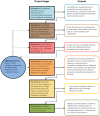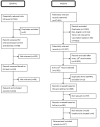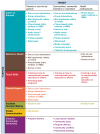"Communicate to vaccinate": the development of a taxonomy of communication interventions to improve routine childhood vaccination
- PMID: 23663327
- PMCID: PMC3655915
- DOI: 10.1186/1472-698X-13-23
"Communicate to vaccinate": the development of a taxonomy of communication interventions to improve routine childhood vaccination
Erratum in
- BMC Int Health Hum Rights. 2013;13:37
Abstract
Background: Vaccination is a cost-effective public health measure and is central to the Millennium Development Goal of reducing child mortality. However, childhood vaccination coverage remains sub-optimal in many settings. While communication is a key feature of vaccination programmes, we are not aware of any comprehensive approach to organising the broad range of communication interventions that can be delivered to parents and communities to improve vaccination coverage. Developing a classification system (taxonomy) organised into conceptually similar categories will aid in: understanding the relationships between different types of communication interventions; facilitating conceptual mapping of these interventions; clarifying the key purposes and features of interventions to aid implementation and evaluation; and identifying areas where evidence is strong and where there are gaps. This paper reports on the development of the 'Communicate to vaccinate' taxonomy.
Methods: The taxonomy was developed in two stages. Stage 1 included: 1) forming an advisory group; 2) searching for descriptions of interventions in trials (CENTRAL database) and general health literature (Medline); 3) developing a sampling strategy; 4) screening the search results; 5) developing a data extraction form; and 6) extracting intervention data. Stage 2 included: 1) grouping the interventions according to purpose; 2) holding deliberative forums in English and French with key vaccination stakeholders to gather feedback; 3) conducting a targeted search of grey literature to supplement the taxonomy; 4) finalising the taxonomy based on the input provided.
Results: The taxonomy includes seven main categories of communication interventions: inform or educate, remind or recall, teach skills, provide support, facilitate decision making, enable communication and enhance community ownership. These categories are broken down into 43 intervention types across three target groups: parents or soon-to-be-parents; communities, community members or volunteers; and health care providers.
Conclusions: Our taxonomy illuminates and organises this field and identifies the range of available communication interventions to increase routine childhood vaccination uptake. We have utilised a variety of data sources, capturing information from rigorous evaluations such as randomised trials as well as experiences and knowledge of practitioners and vaccination stakeholders. The taxonomy reflects current public health practice and can guide the future development of vaccination programmes.
Keywords: Childhood, Vaccination, Immunisation, Communication, Low- and middle-income country, Intervention, Consumer, Taxonomy, Parents.
Figures






References
-
- Centers for Disease Control and Prevention. Ten great public health achievements-United States, 1900-1999. MMWR Morb Mortal Wkly Rep. 1999;48:241–243. - PubMed
-
- UNICEF and World Health Organization. Global Immunization Data. 2012. http://www.who.int/hpvcentre/Global_Immunization_Data.pdf.
-
- UNICEF and World Health Organisation. Immunization summary. A statistical reference containing data through 2010. New York; 2012.
Publication types
MeSH terms
LinkOut - more resources
Full Text Sources
Other Literature Sources
Medical

